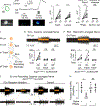Neuroendocrine cells initiate protective upper airway reflexes
- PMID: 38669574
- PMCID: PMC11407116
- DOI: 10.1126/science.adh5483
Neuroendocrine cells initiate protective upper airway reflexes
Abstract
Airway neuroendocrine (NE) cells have been proposed to serve as specialized sensory epithelial cells that modulate respiratory behavior by communicating with nearby nerve endings. However, their functional properties and physiological roles in the healthy lung, trachea, and larynx remain largely unknown. In this work, we show that murine NE cells in these compartments have distinct biophysical properties but share sensitivity to two commonly aspirated noxious stimuli, water and acid. Moreover, we found that tracheal and laryngeal NE cells protect the airways by releasing adenosine 5'-triphosphate (ATP) to activate purinoreceptive sensory neurons that initiate swallowing and expiratory reflexes. Our work uncovers the broad molecular and biophysical diversity of NE cells across the airways and reveals mechanisms by which these specialized excitable cells serve as sentinels for activating protective responses.
Conflict of interest statement
Figures





Comment in
-
Sentinels of the airways.Science. 2024 Apr 19;384(6693):269-270. doi: 10.1126/science.ado9995. Epub 2024 Apr 18. Science. 2024. PMID: 38669581
Similar articles
-
Sentinels of the airways.Science. 2024 Apr 19;384(6693):269-270. doi: 10.1126/science.ado9995. Epub 2024 Apr 18. Science. 2024. PMID: 38669581
-
Differences in respiratory reflex responses from the larynx, trachea, and bronchi in anesthetized female subjects.Anesthesiology. 1996 Jan;84(1):70-4. doi: 10.1097/00000542-199601000-00008. Anesthesiology. 1996. PMID: 8572356
-
Physiological and pathophysiological implications of upper airway reflexes in humans.Jpn J Physiol. 2000 Feb;50(1):3-14. doi: 10.2170/jjphysiol.50.3. Jpn J Physiol. 2000. PMID: 10866692 Review.
-
Laryngeal and tracheal afferent nerve stimulation evokes swallowing in anaesthetized guinea pigs.J Physiol. 2013 Sep 15;591(18):4667-79. doi: 10.1113/jphysiol.2013.256024. Epub 2013 Jul 15. J Physiol. 2013. PMID: 23858010 Free PMC article.
-
Role of the parasympathetic nervous system and of cholinergic mechanisms in bronchial hyperreactivity.Bull Eur Physiopathol Respir. 1986;22 Suppl 7:112-42. Bull Eur Physiopathol Respir. 1986. PMID: 3006841 Review.
Cited by
-
Intrinsic electrical activity drives small-cell lung cancer progression.Nature. 2025 Mar;639(8055):765-775. doi: 10.1038/s41586-024-08575-7. Epub 2025 Feb 12. Nature. 2025. PMID: 39939778 Free PMC article.
-
Assessing agreement among non-invasive indicators for inspiratory effort during pressure support ventilation.Front Med (Lausanne). 2025 Mar 5;12:1561017. doi: 10.3389/fmed.2025.1561017. eCollection 2025. Front Med (Lausanne). 2025. PMID: 40109733 Free PMC article.
-
Evaluate the safety of a novel photohydrolysis technology used to clean and disinfect indoor air: A murine study.PLoS One. 2024 Oct 9;19(10):e0307031. doi: 10.1371/journal.pone.0307031. eCollection 2024. PLoS One. 2024. PMID: 39383125 Free PMC article.
-
Cellular heterogeneity and patterning strategies as revealed by upper respiratory epithelium single cell atlas.iScience. 2025 Jun 7;28(7):112845. doi: 10.1016/j.isci.2025.112845. eCollection 2025 Jul 18. iScience. 2025. PMID: 40612507 Free PMC article.
-
Topical ATP Application in the Peripheral Swallowing-Related Regions Facilitates Triggering of the Swallowing Reflex Involving P2X3 Receptors.Function (Oxf). 2025 Mar 24;6(2):zqaf010. doi: 10.1093/function/zqaf010. Function (Oxf). 2025. PMID: 40042973 Free PMC article.
References
-
- Daniels SK, Brailey K, Priestly DH, Herrington LR, Weisberg LA, Foundas AL, Aspiration in patients with acute stroke. Arch Phys Med Rehabil. 79, 14–19 (1998). - PubMed
-
- Doggett DL, Tappe KA, Mitchell MD, Chapell R, Coates V, Turkelson CM, Prevention of pneumonia in elderly stroke patients by systematic diagnosis and treatment of dysphagia: An evidence-based comprehensive analysis of the literature. Dysphagia. 16, 279–295 (2001). - PubMed
-
- Lee LY, Yu J, Sensory nerves in lung and airways. Compr. Physiol. 4, 287–324 (2014). - PubMed
Publication types
MeSH terms
Substances
Grants and funding
LinkOut - more resources
Full Text Sources
Molecular Biology Databases

